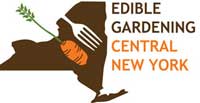Kindred Kingdoms
|  | Jean & Lenny Soprano of Kindred Kingdoms presented a wonderful program for us last month.
Some people wanted to know how they could donate to this mission, which is financed solely by donations.
You can donate on their website or mail donations to:
Kindred Kingdoms Wildlife Rehabilitation Inc.
211 Sutton Road
Pennellville, NY 13132
|
Bringing Back the Pollinators
Oct. 10
|
 | | Black is a co-author of this excellent book |
|
What we can all do to protect these essential creaturesElizabeth E. Rowley LectureDate: Oct. 10 at 7:30 pm Location: Cornell's Statler Hall Auditorium Speaker: Scott Black, Executive Director, The Xerces Society for Inverteberate Conservation; Chair of the International Union for Conservation of Nature Butterfly Specialist Group Black will discuss the importance of insect pollinators, outline the groups of insects that provide pollination services in North America, and present straightforward actions that each and every one of us can take to protect and provide habitat for pollinators. For more information ...
|
If these trees
could talk
Mon. Oct. 15
10:30am - noon |
 | Young oak
|
| |
Join Baltimore Woods Naturalist Tom Meier on a journey through time. The shape of the forests at Baltimore Woods is intimately tied to the lifestyles of all the people who came before. This hike will take an inspiring look at the history of the preserve and the ever-changing relationships between people and the land, as told through the eyes of the colorful autumn trees.
$5 members, $15/family;
$8 nonmembers, $25/family.
Baltimore Woods Nature Center
4007 Bishop Hill Rd., Marcellus
(315) 673-1350
|
| Project BudBurst's 2nd annual Fall into Phenology |  |
Share your fall observations of plants changing color, shedding leaves, and more. Read more at budburst.org/fallYou can submit data for this campaign until Oct. 31.
|
iMapInvasive Workshop
Oct. 18 7-8:30 pm
|
 | | Japanese honeysuckle |
| Baldwinsville Public Library
33 E. Genesee St. Baldwinsville
Do you know where to find up-to-date maps of invasive species sweeping across New York State? Have you seen a new infestation but don't know where to report it? If you're looking to join the statewide group of students, teachers, public and private institutions responding to and reporting new threats, join Cornell Cooperative Extension's iMapInvasives mapping workshop
For details and to register www.extendonondaga.org or contact Sherry Martin at 315.424.9485 ext. 232, sm674@cornell.edu
|
| Our Habitat Garden |  |
Visit Our Habitat Garden website for information on providing habitat, earth-friendly gardening practices, plants, and various creatures here in Central New York.
|
| HGCNY on Facebook |
As as more of us participate on our Facebook page, this will become a useful resource for asking (and answering!) local HGCNYers' questions about habitat gardening. |
|
Join HGCNY!
|  |
Becoming an official member of HGCNY is easy: just join Wild Ones! When you're a Wild Ones member, you're automatically an official member of HGCNY. |
|
Our Edible Garden
|  | Visit OurEdibleGarden.org to see an example of a Central New York edible garden, the perfect companion to your habitat garden.
|
| Interested in Edible Gardening? | 
|
If you'd like to get information on Edible Gardening CNY, just email John to find out about edible gardening tours and monthly programs. Free and open to the public! |
|
Greetings!
 | | Never too early to start! |
For our October meeting, we're pleased to bring back one of our most popular presenters, Andrew Saunders, retired SUNY-ESF professor. In the past, he's talked with us about the fascinating black walnut tree (and even brought along a delicious black walnut pie!), and he showed us how to keep nature journals. This time he'll present tips on nature photography. Come learn from an expert nature observer. This program is suitable for any level of photographer. When: Sunday Oct. 28 at 2:00 pm at Where: Liverpool Library ( Directions) Free and open to the publicMark your calendars for the last Sunday of the month for a year of terrific programs! They're free and open to the public. On the wings of pollinators
 | Bumblebee on joe-pye
|
Did you know that pollinators are responsible for one of every three bites of food we eat - and that these pollinators are at risk? The world has been buzzing with news of the honey bees' Colony Collapse Disorder, but native pollinators are in trouble, too. Learn about the importance of pollination in our own gardens and beyond, and about the challenges bees face. And learn the simple steps you can take in your own yard to help these useful creatures--and to enjoy the busy-ness and buzzy-ness they can bring to your yard! Where: Beaver Lake When: Thursday, October 11 at 7:00 pm. Cost: $5 Registration is required.
Call: Beaver Lake at 638-2519Janet Allen President, HGCNY |
|
|
Featured plant: Northern maidenhair fern
 The beautiful Northern Maidenhair fern (Adiantum pedatum) is surprisingly easy to grow. The beautiful Northern Maidenhair fern (Adiantum pedatum) is surprisingly easy to grow.
It will grow in part sun to (preferably) shade in moist alkaline to slightly acidic soil. It's just the right size (1-2 ft. tall and about 2 ft. wide) to be noticeable, but not overpowering.
 | | Closeup |
Unlike most ferns, it has a circular appearance--as William Cullina says "as a child sketches the sun," though not perfect circles, but rather "like the digits of your hand." It has distinctive black, wiry stems.
Cullina notes that "as long as the soil remains damp through the summer, they are easy to please." (Ed.: This past drought-plagued summer was the first time my own maidenhair fern browned up a bit.)
|
|
Help save the monarch butterfly by collecting milkweed seeds
 | | Milkweed beetles |
The Wild Ones Wild for Monarchs campaign is collecting milkweed seeds in large-scale milkweed restoration projects.
Here's how you can participate:
Steps for collecting:
* Please obtain permission to collect milkweed.
* Do not over-collect in one area. Pick less than 50% at each site.
Safety Note: Take care, milkweed sap can harm eyes. Do not collect near busy highways.
Easy Collection Steps:
1.Collect clean mature pods (as they begin to split) from native wild plants only.
* Note: Don't collect pods that have numerous milkweed beetles on them--they're eating the milkweed seeds. Also, make sure no beetles get into your seed bag, giving them an easy, gourmet meal! (See photo above)
* Paper bags work well. Don't use plastic.
* Please dry the pods.
* If you want to, clean the fluff off the seeds, and pull or shake seeds off.
2. For each location, make a new labeled bag.
3. Each species needs its own bag.
4. Label each bag with this information:
* Type of milkweed (Common/Swamp/Butterflyweed)
* Your name/address/email
* Collection Date and Location (Zip/County/State)
* Size of milkweed population (small/medium/large)
* Soil type (sand/clay/other)
* Ecoregion or plant community if known
* Comments
What to do with them:
We can save a portion of these wild-collected seeds for our own milkweed propagation and send a portion to Monarch Watch for large-scale restoration projects.
You can send them directly yourself to Monarch Watch or bring them to the next meeting and we'll send them along.
For more information, visit the Monarch Watch guide to milkweed collecting.
|
|
Help birds with these projects
 | Gray dogwood
(Cornus racemosa) |
We help birds a lot by planting lots of native trees and shrubs. In fact, recent research from Cornell has found, "Because fledgling survival increases as the amount of understory vegetation increases, planting dense shrubs in suburban and urban yards will likely benefit the birds, even in highly urbanized landscapes." Read more about this study ...
Another way we can help, though, is by participating in these Cornell Lab of Ornithology projects:
Project FeederWatch - 15,000 people have participated in this project. (And it's my own favorite citizen science project!) Here's a video that shows how to participate. PFW runs from Nov. 10 to Apr. 5 and is a fun winter activity. Enroll here.
Merlin - This a smart online bird ID tool that combines artificial intelligence with input from real-life bird watchers to produce an online "wizard" that helps people ID birds quickly and connects them to more information.
To build Merlin, the Cornell Lab needs to know how thousands of people remember and describe birds. You can help by participating in fun online activities that help Merlin understand what bird watchers see. The more you play, the more you'll help Merlin become a true bird ID wizard.
This may sound complicated, but the various tasks are actually quite simple. For example, the current task is simply to use the photo crop tool (provided in Merlin) to outline the shape of the bird from its surroundings. Easy for people, but not so easy for computers until we teach them how! Go to Merlin and learn how to participate (and this project is free). |
|
Sara Stein: On paths and lawns
 | | Our front path |
Once one begins to think in terms of paths, one realizes that they already exist although invisibly.
One doesn't walk across a lawn every which way, only in the particular ways that get one from place to place. Some of the places are spaces in the human sense of the word-open areas for sitting, eating, playing. These are the clearings.
Others might be spaces in the more usual animal sense of resources that are visited regularly: garbage pail, woodpile, vegetable garden, sandbox.
It's astonishing how little land a family really uses and how much can be left as Lebensraum for others. Who ever uses the front yard? Who strolls along the fence? When does anybody sit in the corner of the yard?
~ Sara Stein, Noah's Garden: Restoring the Ecology of Our Own Back Yards, 1993, pp. 46-47
|
|
Share a photo of your Waystation
 | | Monarch Waystation sign |
If you have milkweeds, nectar plants, and refrain from using pesticides, you're helping monarch butterflies survive, and you may even have an official Monarch Waystation.
If you've met the Monarch Watch requirements for providing for the monarch's needs, you can become certified and are eligible to purchase a sign. (Note: Monarch Watch includes non-natives on their plant list, but we suggest natives instead!)
If you have a certified Waystation, send a digital photo, and we'll create a page on our HGCNY website showing the Monarch Waystations in CNY.
Please include your Waystation number and how you would like to be identified (e.g. "Syracuse," "Sam from Syracuse," "Sam Smith at 100 Main St., Syracuse," etc.--whatever level of specificity you're comfortable with).
You're also welcome to include a brief paragraph indicating what kind of milkweed and other native nectar plants are in your Waystation and any other information of interest.
Our first Waystation
The Women's Garden Club of Baldwinsville submitted our first Monarch Waystation, Yevich Trail!
|
|
HGCNY Shopping Guide
 | | (Click image to download) |
To help you find native plants in CNY, we've compiled a list of plants offered by several local nurseries.
REMEMBER, nurseries can sell out of any particular plant, so it's a good idea to call before setting out on your shopping trip!
DOWNLOAD: This guide is available online as a free .pdf download.
|
|
|
|
|